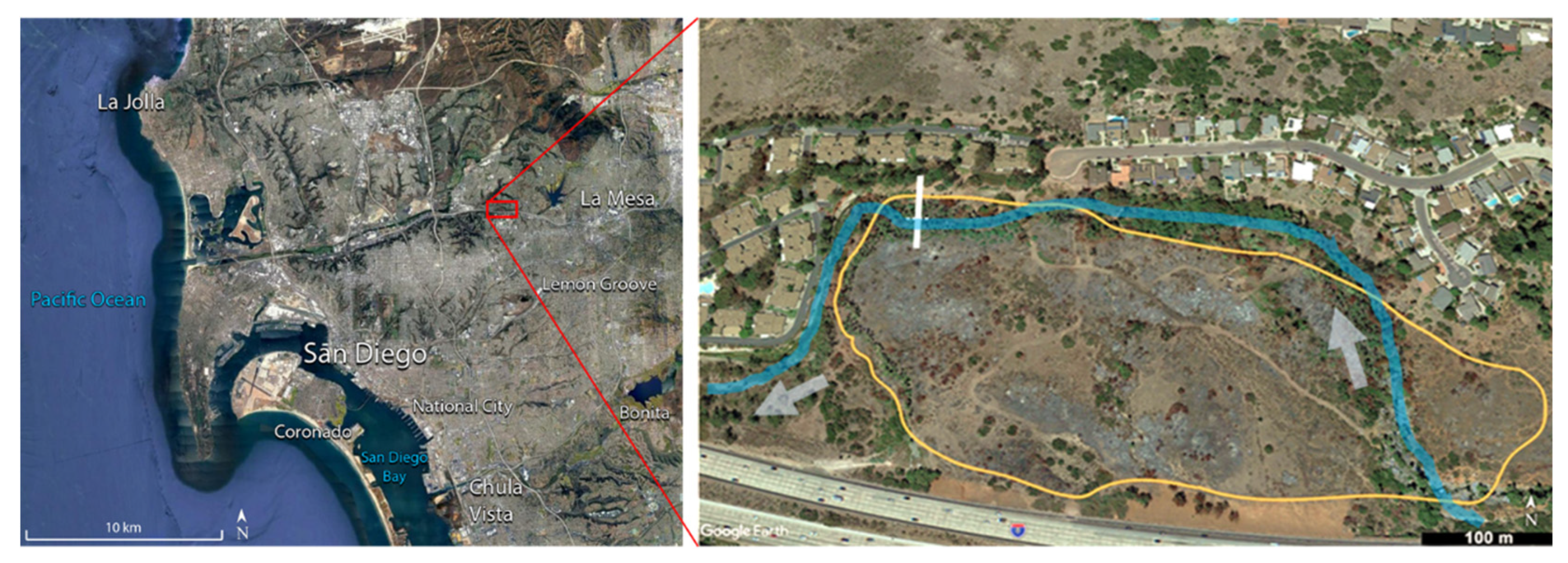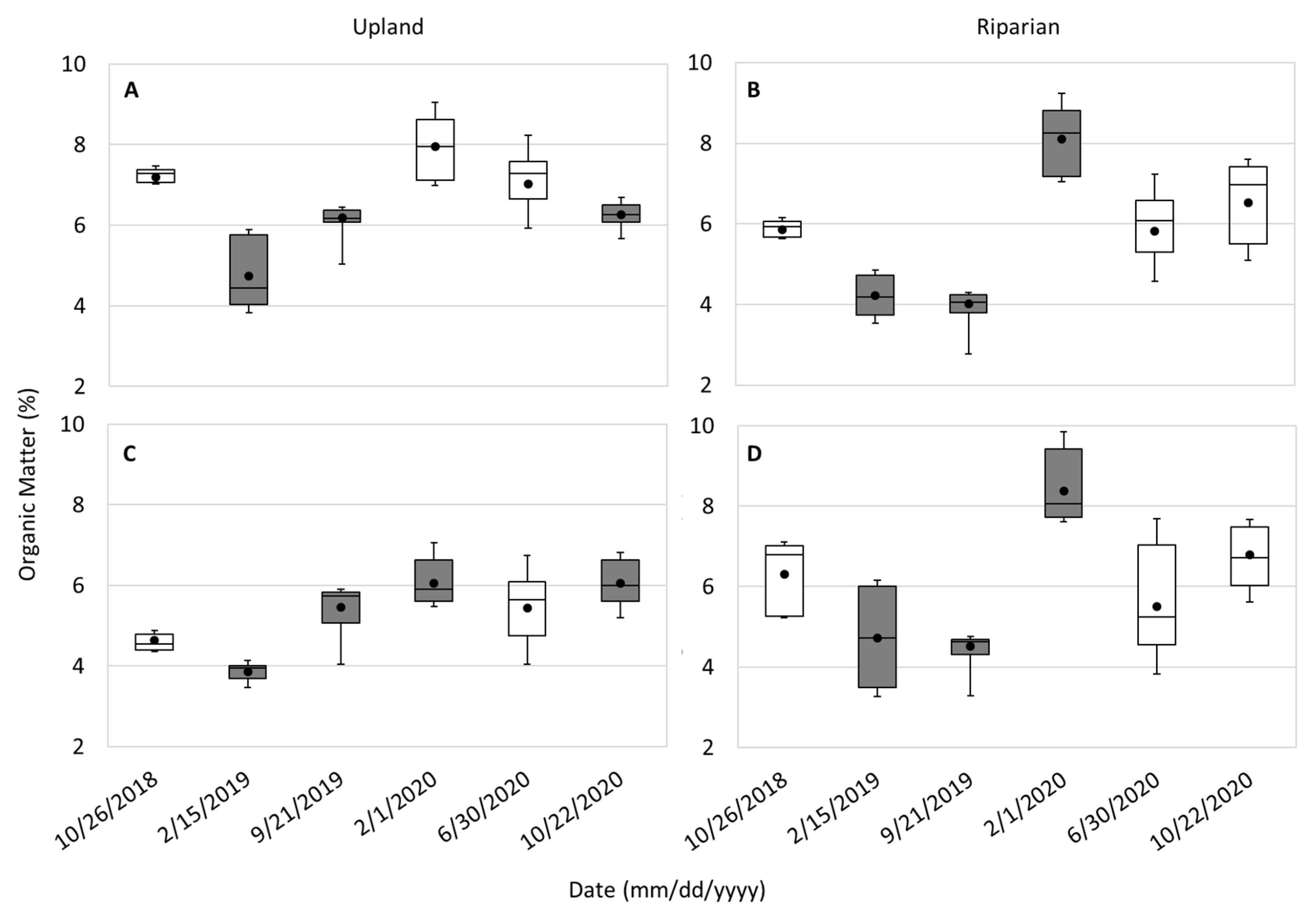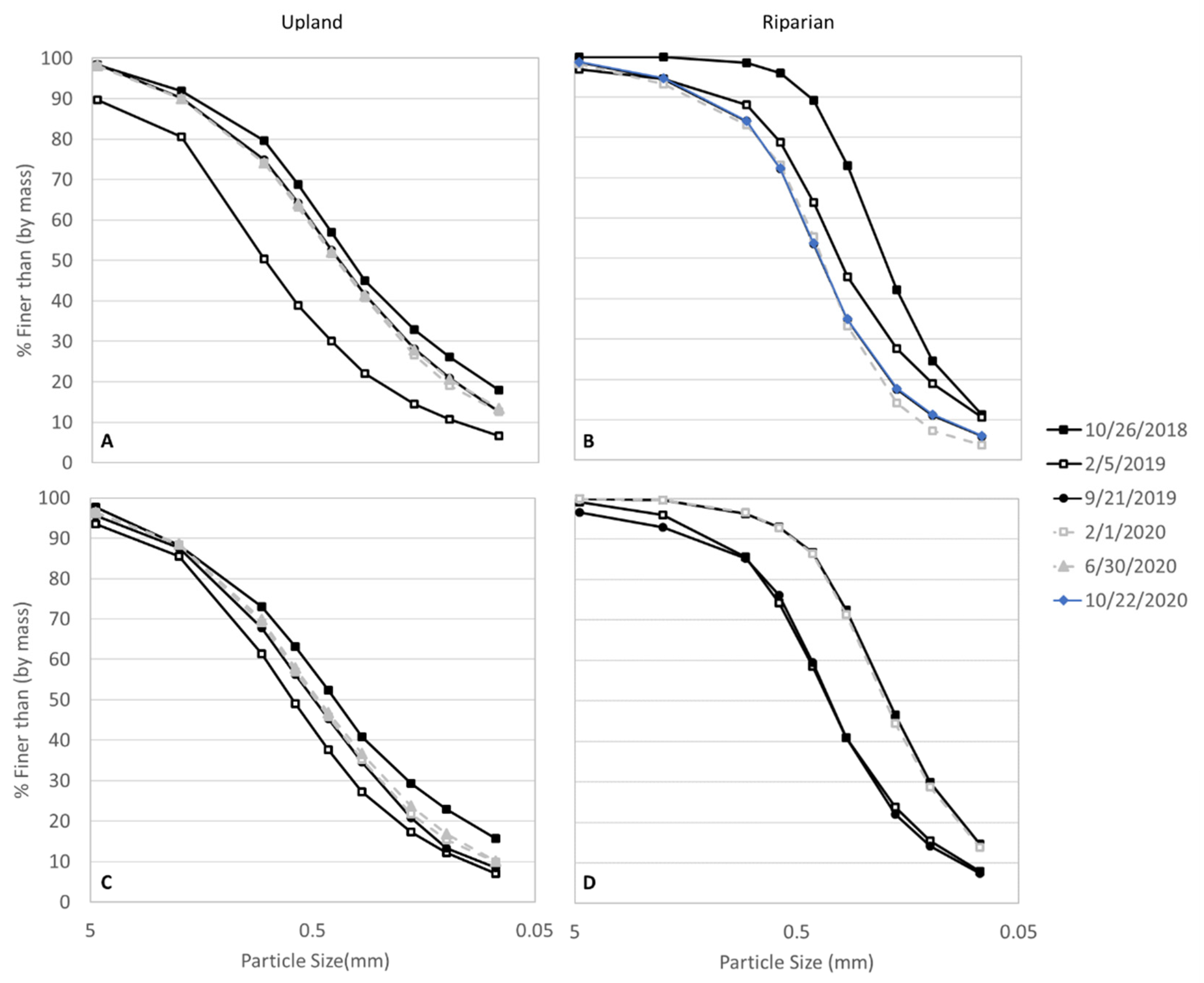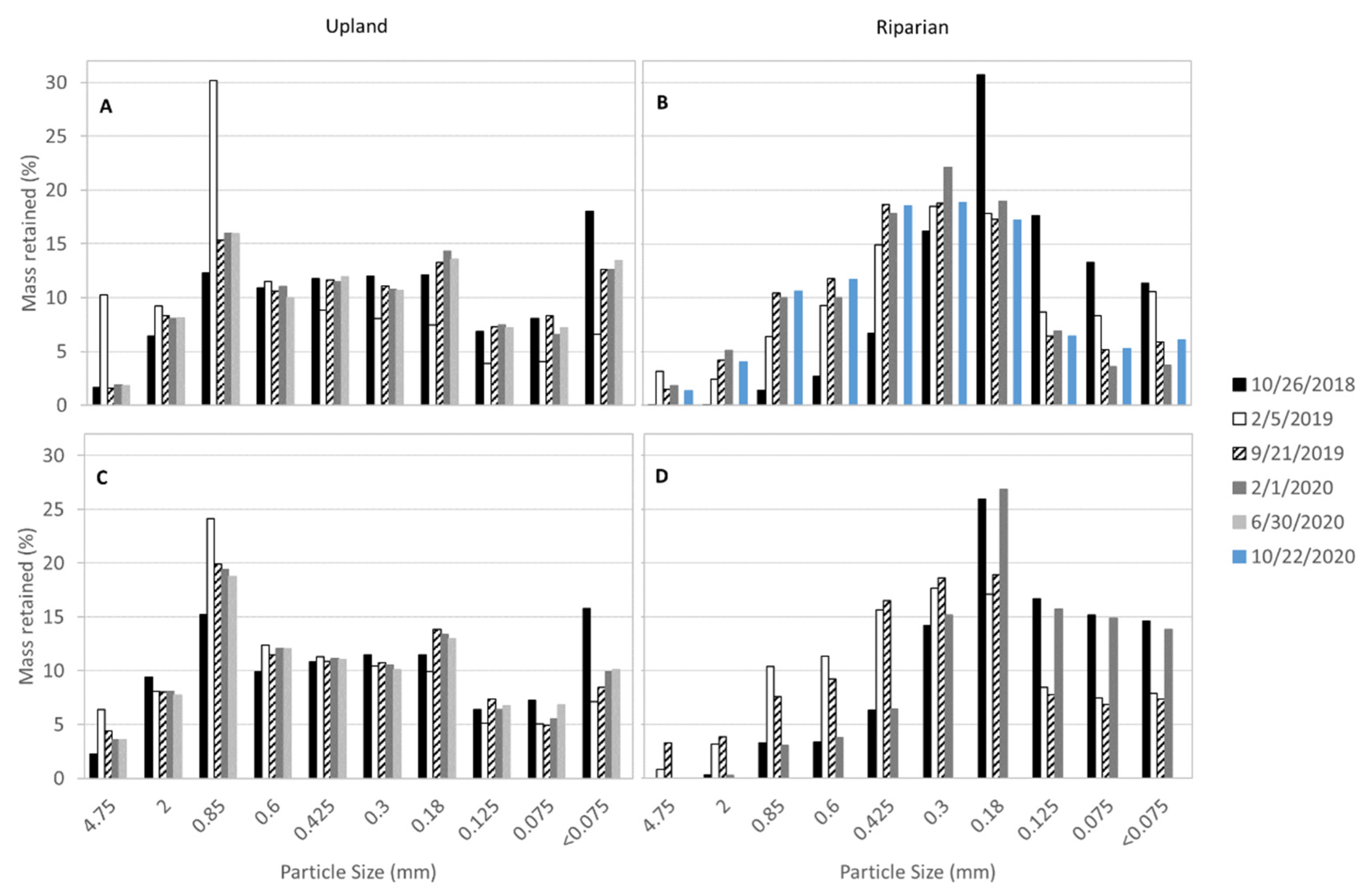Upland and Riparian Surface Soil Processes in an Urban Creek with Native and Non-Native Vegetation after Fire
Abstract
:1. Introduction
2. Materials and Methods
2.1. Study Area
2.2. Precipitation
2.3. Soil Sampling
2.4. Loss on Ignition
2.5. Soil Classification
2.6. Stream-Bed Material
3. Results
3.1. Precipitation
3.2. Soil Organic Matter
3.3. Initial Soil Classification
3.4. Particle-Size Distribution
3.5. Stream-Bed Material
4. Discussion
4.1. Organic Matter
4.2. Sediment Transport Patterns
5. Conclusions
Author Contributions
Funding
Institutional Review Board Statement
Informed Consent Statement
Data Availability Statement
Acknowledgments
Conflicts of Interest
References
- Bowman, D.M.J.S.; Balch, J.K.; Artaxo, P.; Bond, W.J.; Carlson, J.M.; Cochrane, M.A.; D’Antonio, C.M.; DeFries, R.S.; Doyle, J.C.; Harrison, S.P.; et al. Fire in the Earth System. Science 2009, 324, 481–484. [Google Scholar] [CrossRef] [PubMed]
- Gorte, R. The Rising Cost of Wildfire Protection. Headwaters Econ. 2013, 19. Available online: https://www.baileyhealthyforests.org/wp-content/uploads/2013/12/fire-costs-background-report.pdf (accessed on 19 January 2022).
- Mathews, L.; Kinoshita, A. Urban Fire Severity and Vegetation Dynamics in Southern California. Remote Sens. 2021, 13, 19. [Google Scholar] [CrossRef]
- Syphard, A.D.; Radeloff, V.C.; Keeley, J.E.; Hawbaker, T.J.; Clayton, M.K.; Stewart, S.I.; Hammer, R.B. Human influence on California fire regimes. Ecol. Appl. 2007, 17, 1388–1402. [Google Scholar] [CrossRef] [PubMed]
- Syphard, A.D.; Brennan, T.J.; Keeley, J.E. Drivers of chaparral type conversion to herbaceous vegetation in coastal Southern California. Divers. Distrib. 2019, 25, 90–101. [Google Scholar] [CrossRef] [Green Version]
- White, M.D.; Greer, K.A. The effects of watershed urbanization on the stream hydrology and riparian vegetation of Los Peñasquitos Creek, California. Landsc. Urban Plan. 2006, 74, 125–138. [Google Scholar] [CrossRef]
- D’Antonio, C.M. Fire, Plant Invasions, and Global Changes. In Invasive Species in a Changing World; Hobbs, R.J., Ed.; Island Press: Covela, CA, USA, 2000; pp. 65–93. ISBN 978-1-59726-337-5. [Google Scholar]
- Coffman, G.C.; Ambrose, R.F.; Rundel, P.W. Wildfire promotes dominance of invasive giant reed (Arundo donax) in riparian ecosystems. Biol. Invasions 2010, 12, 2723–2734. [Google Scholar] [CrossRef] [Green Version]
- Godefroid, S.; Koedam, N. Urban plant species patterns are highly driven by density and function of built-up areas. Landsc. Ecol. 2007, 22, 1227–1239. [Google Scholar] [CrossRef]
- Aronson, M.F.; Lepczyk, C.A.; Evans, K.L.; Goddard, M.; Lerman, S.B.; MacIvor, J.S.; Nilon, C.H.; Vargo, T. Biodiversity in the city: Key challenges for urban green space management. Front. Ecol. Environ. 2017, 15, 189–196. [Google Scholar] [CrossRef] [Green Version]
- Stover, J.E.; Keller, E.A.; Dudley, T.L.; Langendoen, E.J. Fluvial Geomorphology, Root Distribution, and Tensile Strength of the Invasive Giant Reed, Arundo Donax and Its Role on Stream Bank Stability in the Santa Clara River, Southern California. Geosciences 2018, 8, 304. [Google Scholar] [CrossRef] [Green Version]
- Mathews, L.; Kinoshita, A. Vegetation and Fluvial Geomorphology Dynamics after an Urban Fire. Geosciences 2020, 10, 317. [Google Scholar] [CrossRef]
- California Invasive Plant Council (Cal-IPC) Arundo Donax (Giant Reed): Distribution and Impact Report. 2011. Available online: https://www.cal-ipc.org/wp-content/uploads/2017/11/Arundo_Distribution_Impact_Report_Cal-IPC_March-2011_small.pdf (accessed on 19 January 2022).
- Pettit, N.E.; Naiman, R.J. Fire in the Riparian Zone: Characteristics and Ecological Consequences. Ecosystems 2007, 10, 673–687. [Google Scholar] [CrossRef]
- Cushman, J.H.; Gaffney, K.A. Community-level consequences of invasion: Impacts of exotic clonal plants on riparian vegetation. Biol. Invasions 2010, 12, 2765–2776. [Google Scholar] [CrossRef]
- Stein, E.D.; Brown, J.S.; Hogue, T.S.; Burke, M.P.; Kinoshita, A. Stormwater contaminant loading following southern California wildfires. Environ. Toxicol. Chem. 2012, 31, 2625–2638. [Google Scholar] [CrossRef] [PubMed]
- Lamb, M.P.; Scheingross, J.S.; Amidon, W.H.; Swanson, E.; Limaye, A. A model for fire-induced sediment yield by dry ravel in steep landscapes. J. Geophys. Res. Earth Surf. 2011, 116. [Google Scholar] [CrossRef] [Green Version]
- DeBano, L.F.; Rice, R.M. Water Repellent Soils: Their Implications in Forestry. J. For. 1973, 71, 220–223. [Google Scholar] [CrossRef]
- Lewis, S.A.; Wu, J.Q.; Robichaud, P.R. Assessing burn severity and comparing soil water repellency, Hayman Fire, Colorado. Hydrol. Process. 2006, 20, 1–16. [Google Scholar] [CrossRef]
- DeBano, L.F.; Rice, R.M.; Eugene, C.C. Soil Heating in Chaparral Fires: Effects on Soil Properties, Plant Nutrients, Erosion, and Runoff; Res. Paper PSW-RP-145; U.S. Department of Agriculture, Forest Service, Pacific Southwest Forest and Range Experiment Station: Berkeley, CA, USA, 1979; Volume 145, 21p. Available online: https://www.fs.usda.gov/treesearch/pubs/29933 (accessed on 19 January 2022).
- Moody, J.A.; Shakesby, R.A.; Robichaud, P.R.; Cannon, S.H.; Martin, D.A. Current research issues related to post-wildfire runoff and erosion processes. Earth-Sci. Rev. 2013, 122, 10–37. [Google Scholar] [CrossRef]
- Robichaud, P. Fire effects on infiltration rates after prescribed fire in Northern Rocky Mountain forests, USA. J. Hydrol. 2000, 231–232, 220–229. [Google Scholar] [CrossRef]
- Letey, J. Causes and consequences of fire-induced soil water repellency. Hydrol. Process. 2001, 15, 2867–2875. [Google Scholar] [CrossRef]
- Kraebel, C.J. The La Crescenta Flood. Am. For. 1934, 40, 286–287. [Google Scholar]
- Rulli, M.C.; Rosso, R. Hydrologic response of upland catchments to wildfires. Adv. Water Resour. 2007, 30, 2072–2086. [Google Scholar] [CrossRef]
- Wittenberg, L.; Malkinson, D.; Barzilai, R. The differential response of surface runoff and sediment loss to wildfire events. CATENA 2014, 121, 241–247. [Google Scholar] [CrossRef]
- DeBano, L.F.; Neary, D.G.; Folliott, P.F. Fire: Its Effect on Soil and Other Ecosystem Resources; John Wiley & Sons, Inc.: New York, NY, USA, 1998; pp. 71–159. ISBN 978-0-471-16356-5. [Google Scholar]
- Florsheim, J.; Keller, E.A.; Best, D.W. Fluvial sediment transport in response to moderate storm flows following chaparral wildfire, Ventura County, southern California. GSA Bull. 1991, 103, 504–511. [Google Scholar] [CrossRef]
- Nyman, P.; Smith, H.G.; Sherwin, C.B.; Langhans, C.; Lane, P.N.; Sheridan, G.J. Predicting sediment delivery from debris flows after wildfire. Geomorphology 2015, 250, 173–186. [Google Scholar] [CrossRef]
- Syvitski, J.P.; Peckham, S.; Hilberman, R.; Mulder, T. Predicting the terrestrial flux of sediment to the global ocean: A planetary perspective. Sediment. Geol. 2003, 162, 5–24. [Google Scholar] [CrossRef]
- Chin, A.; Solverson, A.P.; O’Dowd, A.P.; Florsheim, J.L.; Kinoshita, A.M.; Nourbakhshbeidokhti, S.; Sellers, S.M.; Tyner, L.; Gidley, R. Interacting geomorphic and ecological response of step-pool streams after wildfire. GSA Bull. 2019, 131, 1480–1500. [Google Scholar] [CrossRef] [Green Version]
- Robichaud, P.R.; Lewis, S.A.; Brown, R.E.; Ashmun, L.E. Emergency Post-Fire Rehabilitation Treatment Effects on Burned Area Ecology and Long-Term Restoration. Fire Ecol. 2009, 5, 115–128. [Google Scholar] [CrossRef]
- Dwire, K.A.; Kauffman, J. Fire and riparian ecosystems in landscapes of the western USA. For. Ecol. Manag. 2003, 178, 61–74. [Google Scholar] [CrossRef] [Green Version]
- Verkaik, I.; Rieradevall, M.; Cooper, S.D.; Melack, J.M.; Dudley, T.L.; Prat, N. Fire as a disturbance in mediterranean climate streams. Hydrobiologia 2013, 719, 353–382. [Google Scholar] [CrossRef]
- Bell, G.P. Ecology and Management of Arundo Donax, and Approaches to Riparian Habitat Restoration in Southern California. Available online: https://ic.arc.losrios.edu/~veiszep/05spr2001/stelmok/g26files/attach5.html (accessed on 19 January 2022).
- Ulery, A.L.; Graham, R.C. Forest Fire Effects on Soil Color and Texture. Soil Sci. Soc. Am. J. 1993, 57, 135–140. [Google Scholar] [CrossRef]
- Oguntunde, P.G.; Abiodun, B.J.; Ajayi, A.E.; van de Giesen, N. Effects of charcoal production on soil physical properties in Ghana. J. Plant Nutr. Soil Sci. 2008, 171, 591–596. [Google Scholar] [CrossRef]
- Certini, G.; Nocentini, C.; Knicker, H.; Arfaioli, P.; Rumpel, C. Wildfire effects on soil organic matter quantity and quality in two fire-prone Mediterranean pine forests. Geoderma 2011, 167–168, 148–155. [Google Scholar] [CrossRef]
- Horel, J.; Splitt, M.; Dunn, L.; Pechmann, J.; White, B.; Ciliberti, C.; Lazarus, S.; Slemmer, J.; Zaff, D.; Burks, J. Mesowest: Cooperative Mesonets in The Western United States. Bull. Am. Meteorol. Soc. 2002, 83, 211–226. [Google Scholar] [CrossRef]
- Alkin, Q.; Kinoshita, A.M. A Case Study of Soil Moisture and Infiltration after an Urban Fire. Fire 2020, 3, 22. [Google Scholar] [CrossRef]
- Wilke, B.-M. Determination of Chemical and Physical Soil Properties. In Monitoring and Assessing Soil Bioremediation; Margesin, R., Schinner, F., Eds.; Soil Biology; Springer: Berlin/Heidelberg, Germany, 2005; pp. 47–95. ISBN 978-3-540-28904-3. [Google Scholar]
- ASTM D6913-04; Standard Test Methods for Particle-Size Distribution (Gradation) of Soils Using Sieve Analysis. 2017. Available online: https://www.astm.org/d6913_d6913m-17.html (accessed on 19 January 2022).
- ASTM D4318-17; Standard Test Methods for Liquid Limit, Plastic Limit, and Plasticity Index of Soils. 2018. Available online: https://www.astm.org/d4318-17e01.html (accessed on 19 January 2022).
- Day, P.R. Particle fractionation and particle-size analysis. In Methods of Soil Analysis; John Wiley & Sons, Ltd.: Hoboken, NJ, USA, 1965; pp. 545–567. ISBN 978-0-89118-203-0. Available online: https://acsess.onlinelibrary.wiley.com/doi/10.2134/agronmonogr9.1.c43 (accessed on 19 January 2022).
- Kroetsch, D.; Wang, C. Particle size distribution. In Soil Sampling and Methods of Analysis; Carter, M.R., Gregorich, E.G., Eds.; Canadian Society of Soil Science; CRC Press: Boca Raton, FL, USA, 2008; pp. 713–725. ISBN 978-0-8493-3586-0. [Google Scholar]
- ASTM D2487; Standard Practice for Classification of Soils for Engineering Purposes (Unified Soil Classification System). Available online: https://www.astm.org/d2487-17e01.html (accessed on 19 January 2022).
- Massey, F.J., Jr. The Kolmogorov-Smirnov Test for Goodness of Fit. J. Am. Stat. Assoc. 1951, 46, 68–78. [Google Scholar] [CrossRef]
- Wolman, M.G. A method of sampling coarse river-bed material. Trans. Am. Geophys. Union 1954, 35, 951–956. [Google Scholar] [CrossRef]
- Potyondy, J.P.; Hardy, T. Use of pebble counts to evaluate fine sediment increase in stream channels. JAWRA J. Am. Water Resour. Assoc. 1994, 30, 509–520. [Google Scholar] [CrossRef]
- Rundel, P.W.; Parsons, D.J. Structural Changes in Chamise (Adenostoma fasciculatum) along a Fire-Induced Age Gradient. Rangel. Ecol. Manag. 1979, 32, 462. [Google Scholar] [CrossRef]
- Wei, X.; Hayes, D.J.; Fernandez, I. Fire reduces riverine DOC concentration draining a watershed and alters post-fire DOC recovery patterns. Environ. Res. Lett. 2021, 16, 024022. [Google Scholar] [CrossRef]
- Keeley, J.E.; Keeley, S.C. Post-Fire Regeneration of Southern California Chaparral. Am. J. Bot. 1981, 68, 524–530. [Google Scholar] [CrossRef]
- Prater, M.R.; DeLucia, E.H. Non-native grasses alter evapotranspiration and energy balance in Great Basin sagebrush communities. Agric. For. Meteorol. 2006, 139, 154–163. [Google Scholar] [CrossRef]
- Hellmers, H.; Horton, J.S.; Juhren, G.; O’Keefe, J. Root Systems of Some Chaparral Plants in Southern California. Ecology 1955, 36, 667–678. [Google Scholar] [CrossRef]
- Bridge, J.S. Hydraulic Interpretation of Grain-size Distributions Using a Physical Model for Bedload Transport. J. Sediment. Res. 1981, 51, 1109–1124. [Google Scholar] [CrossRef]
- Lu, N.; Godt, J.W. Hillslope Hydrology and Stability; Cambridge University Press: Cambridge, UK, 2013. [Google Scholar] [CrossRef]
- Wohlgemuth, P.M. Surface Sediment Transport: A Review of Current Knowledge and a Field Study of Its Spatial and Temporal Distributions in the San Dimas Experimental Forest, California. Master’s Thesis, California State University, Northridge, CA, USA, 1986. [Google Scholar]
- Gabet, E.J. Post-fire thin debris flows: Sediment transport and numerical modelling. Earth Surf. Process. Landf. 2003, 28, 1341–1348. [Google Scholar] [CrossRef]
- Shakesby, R.; Doerr, S. Wildfire as a hydrological and geomorphological agent. Earth Sci. Rev. 2006, 74, 269–307. [Google Scholar] [CrossRef]
- Spencer, D.F.; Colby, L.; Norris, G.R. An evaluation of flooding risks associated with giant reed (Arundo donax). J. Freshw. Ecol. 2013, 28, 397–409. [Google Scholar] [CrossRef]
- Schoelynck, J.; De Groote, T.; Bal, K.; Vandenbruwaene, W.; Meire, P.; Temmerman, S. Self-organised patchiness and scale-dependent bio-geomorphic feedbacks in aquatic river vegetation. Ecography 2011, 35, 760–768. [Google Scholar] [CrossRef]




| Date (mm/dd/yyyy) | Description | |
|---|---|---|
| Riparian | Upland | |
| 10/26/2018 | Burned palm trees near the channel | No vegetation |
| 2/15/2019 | Arundo donax resprouting | No vegetation |
| 9/21/2019 | Arundo donax regrowth | Sparse regrowth |
| 2/1/2020 | Established Arundo donax monocultures | Moderate regrowth |
| 6/30/2020 | Abundant regrowth | Abundant regrowth |
| 10/22/2020 | Abundant regrowth | Abundant regrowth |
| Event # | Date (mm/dd/yyyy) | I15 (mm/hr) | RI (yr) | Total (mm) |
|---|---|---|---|---|
| 1 | 11/29/2018 | 3.3 | <1 | 25.1 |
| 2 | 12/5/2018 | 8.4 | 2 | 92.2 |
| 3 | 1/5/2019 | 1.3 | <1 | 14.2 |
| 4 | 1/12/2019 | 1.8 | <1 | 11.9 |
| 5 | 1/14/2019 | 1.3 | <1 | 32.3 |
| 6 | 1/31/2019 | 3.8 | <1 | 19.1 |
| 7 | 2/2/2019 | 2.8 | <1 | 50.0 |
| 8 | 2/13/2019 | 1.3 | <1 | 64.5 |
| 9 | 3/11/2019 | 1.0 | <1 | 12.2 |
| 10 | 11/19/2019 | 7.4 | <1 | 32.0 |
| 11 | 11/27/2019 | 4.8 | <1 | 50.8 |
| 12 | 12/4/2019 | 4.6 | <1 | 44.7 |
| 13 | 12/23/2019 | 4.3 | <1 | 71.1 |
| 14 | 3/9/2020 | 1.3 | <1 | 15.2 |
| 15 | 3/12/2020 | 3.6 | <1 | 51.3 |
| 16 | 4/6/2020 | 7.6 | 2–5 | 150.4 |
Publisher’s Note: MDPI stays neutral with regard to jurisdictional claims in published maps and institutional affiliations. |
© 2022 by the authors. Licensee MDPI, Basel, Switzerland. This article is an open access article distributed under the terms and conditions of the Creative Commons Attribution (CC BY) license (https://creativecommons.org/licenses/by/4.0/).
Share and Cite
Kinoshita, A.M.; Becerra, R.; Miletić, M.; Mladenov, N. Upland and Riparian Surface Soil Processes in an Urban Creek with Native and Non-Native Vegetation after Fire. Fire 2022, 5, 32. https://doi.org/10.3390/fire5020032
Kinoshita AM, Becerra R, Miletić M, Mladenov N. Upland and Riparian Surface Soil Processes in an Urban Creek with Native and Non-Native Vegetation after Fire. Fire. 2022; 5(2):32. https://doi.org/10.3390/fire5020032
Chicago/Turabian StyleKinoshita, Alicia M., Rey Becerra, Marta Miletić, and Natalie Mladenov. 2022. "Upland and Riparian Surface Soil Processes in an Urban Creek with Native and Non-Native Vegetation after Fire" Fire 5, no. 2: 32. https://doi.org/10.3390/fire5020032
APA StyleKinoshita, A. M., Becerra, R., Miletić, M., & Mladenov, N. (2022). Upland and Riparian Surface Soil Processes in an Urban Creek with Native and Non-Native Vegetation after Fire. Fire, 5(2), 32. https://doi.org/10.3390/fire5020032






